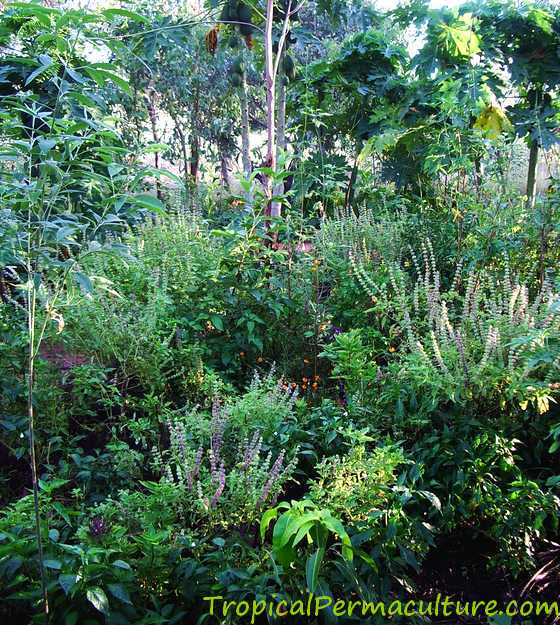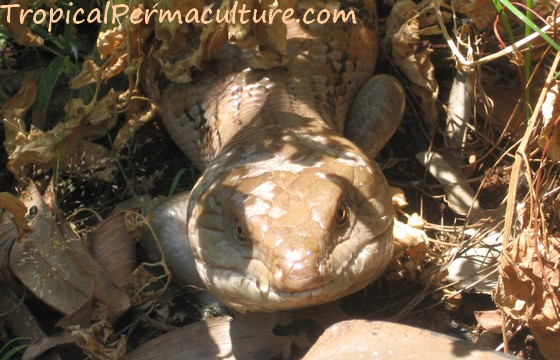Permaculture Design Principle 5
Design For Diversity
Permaculture design aims for as much diversity and variety as possible. It is the exact opposite to conventional agriculture, which relies on huge monocultures and struggles with all the associated problems.
To mix and match as many different plants as possible has many advantages...

- Different plants have different nutrient requirements. Put the right species together and you can fit a lot more plants into a small space without depleting the soil. Different plants also have different shapes and heights, and different light requirements. You can fit a lot more plants into the space you have available than you might think possible!
- Pests and diseases are often very specific in what they like. Having all the same plants growing together makes it easy for the bugs to find them. You're basically putting on a big feast for them, and it makes it easy for bugs and diseases to spread.
- In a mixed and varied garden diseases rarely get a foothold. They can only move between related plants, so just don't plant too many of the same plants next to each other. Mix and spread them around.
- Some bugs identify plants by their look. If you mix say your cabbages with taller herbs and flowers and spread them around the garden they are much harder for cabbage moths to find.
Moths can not recognise the cabbage as easily if it hides amongst dill and carrots and marigolds. - Strong smelling herbs confuse insects that find their food by scent.
- If you keep the bugs searching for their favourite plants, a lizard or bird can get the bugs before the bugs get your best broccoli.
- Beneficial insects have different food requirements altogether. Obviously they don't live off your vegetables or they wouldn't be beneficial, right? So you need other plants in addition to your vegetables.
- The more different species you mix in with your food crops and the more native species you manage to fit in your garden, the more local wildlife and beneficial insects will take up residence.
 One of the many Blue Tongue Lizards that live in my permaculture garden.
One of the many Blue Tongue Lizards that live in my permaculture garden.- Lizards, frogs, birds and good bugs all help keeping things like bad bugs and snails under control.
- Some plants from different species really like growing together and benefit each other. I'm sure you heard of companion planting. Permaculture designs make use of those connections.
- There are many different varieties of individual vegetables. Some tomato varieties are particularly nice for eating fresh, some are good for bottling. Some varieties fruit earlier, some later. Mix them and you will have a longer tomato season.
- Every variety has slightly different preferences regarding soil and climate. Some may do better in your garden than others. Some are resistant to certain diseases. It's worth tracking down the old heirloom varieties and planting two or three different kinds rather than relying on just one species.
- Mix in some deep rooted plants to capture the nutrients that leach past the reach of the more shallow rooted vegetables. That way nothing gets wasted.
And that are just some of the benefits of diversity in your garden.
The more variety a design has, the more successful and stable the system will be.
Have a look at nature, a forest, a wildflower meadow, a wetland... There is no single area that has only one plant species. It's always a mixture of species that are suited to the conditions and support each other.
I think the hardest thing to do when starting with permaculture design is to let go of the idea that a food or vegetable garden has to be a separate plot, away from the rest of the garden, that things have to grow in rows or in their allotted beds, that the orchard is a different part again and has only fruit trees... and so on and so forth.
Forget all that. It doesn't make sense!
Permaculture design is not about making a vegetable garden. It's about integrating
food plants into your garden while creating a healthy and balanced ecological system.
Because it's the much smarter and easier way to grow fruit and vegetables.
I don't have a vegetable garden. I do have a kitchen garden though. It's the area of my garden that is closest to my kitchen door, hence I call it my kitchen garden, which sounds nicer than zone 1. (That would be the proper permaculture term, but I'm not that hard core).
Sure, all my most used herbs and vegetables grow in that kitchen garden area. Saves me running around more than necessary.
But there are also a few native trees that are always full of birds. There are flowers that I grow just for the sake of having pretty flowers, a beautifully scented vine climbing up one veranda post, some shrubs with berries that the birds like, some wildflowers that I leave alone to do what they like, two smaller fruit trees...
It wouldn't make sense to separate the food plants from the others.
It works a lot better like this, for the vegetables, the birds and for me.
Next: Permaculture Principle 6 - Design Scale And Use Of Space
Index of all Permaculture Design Principles